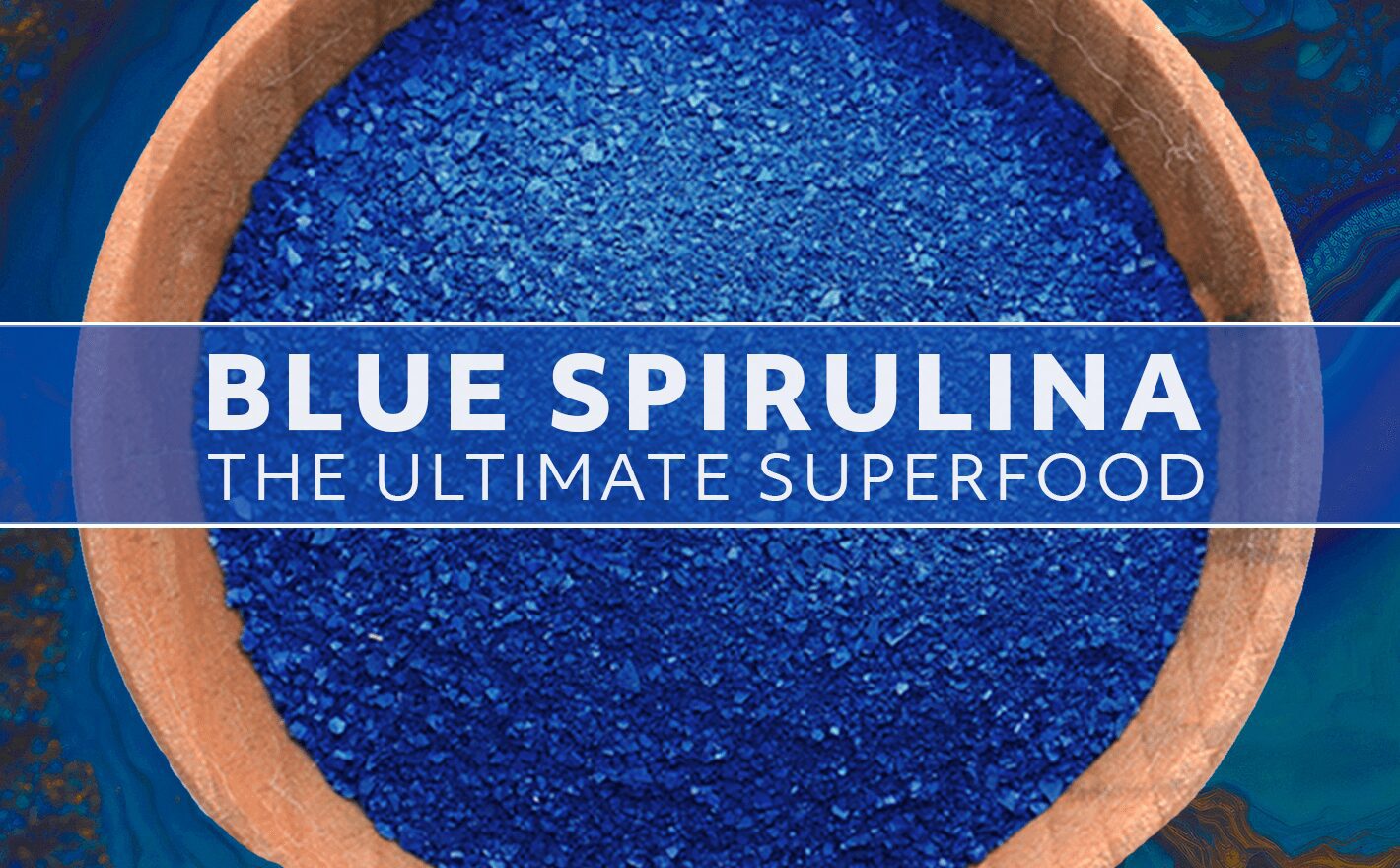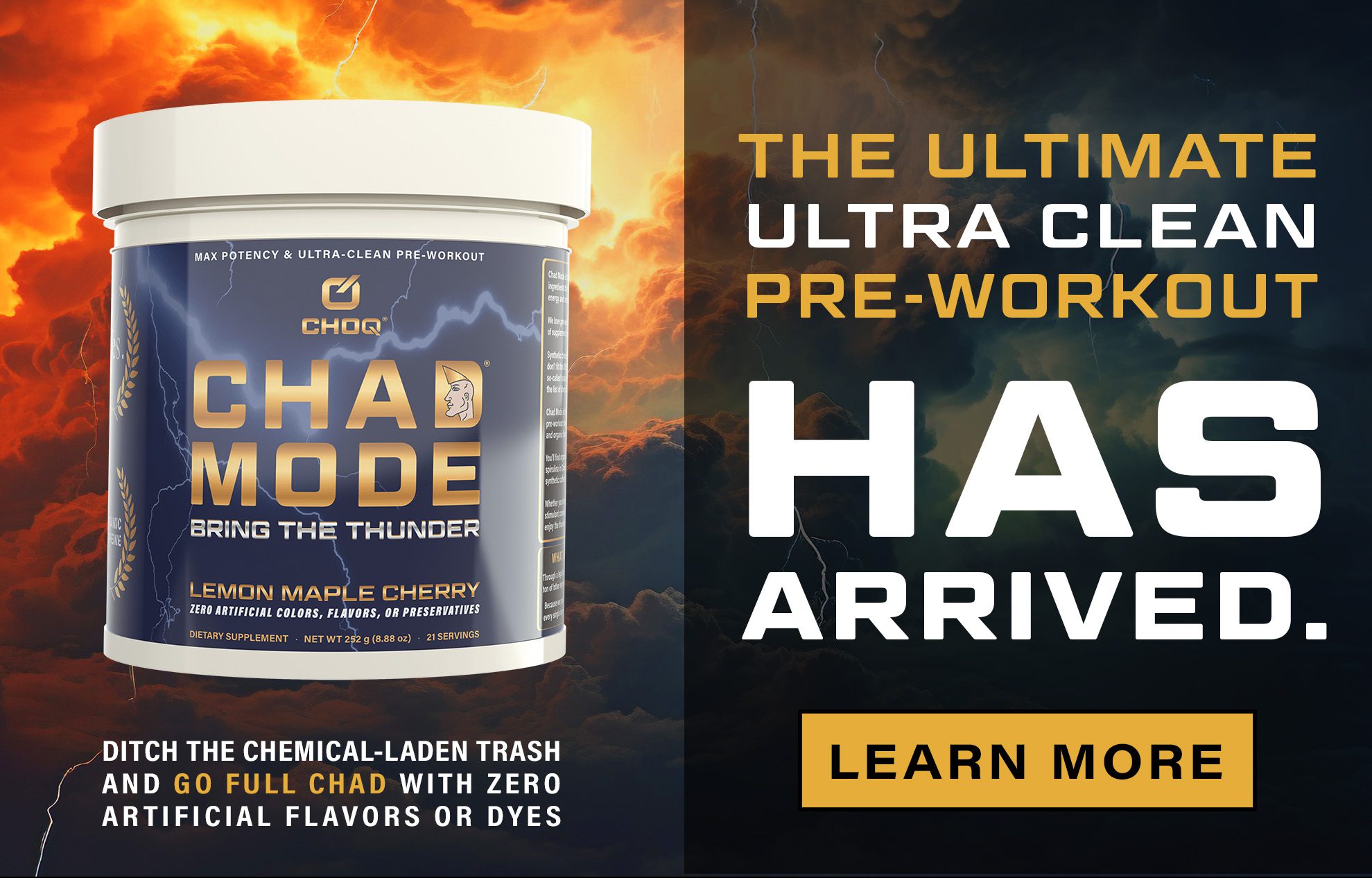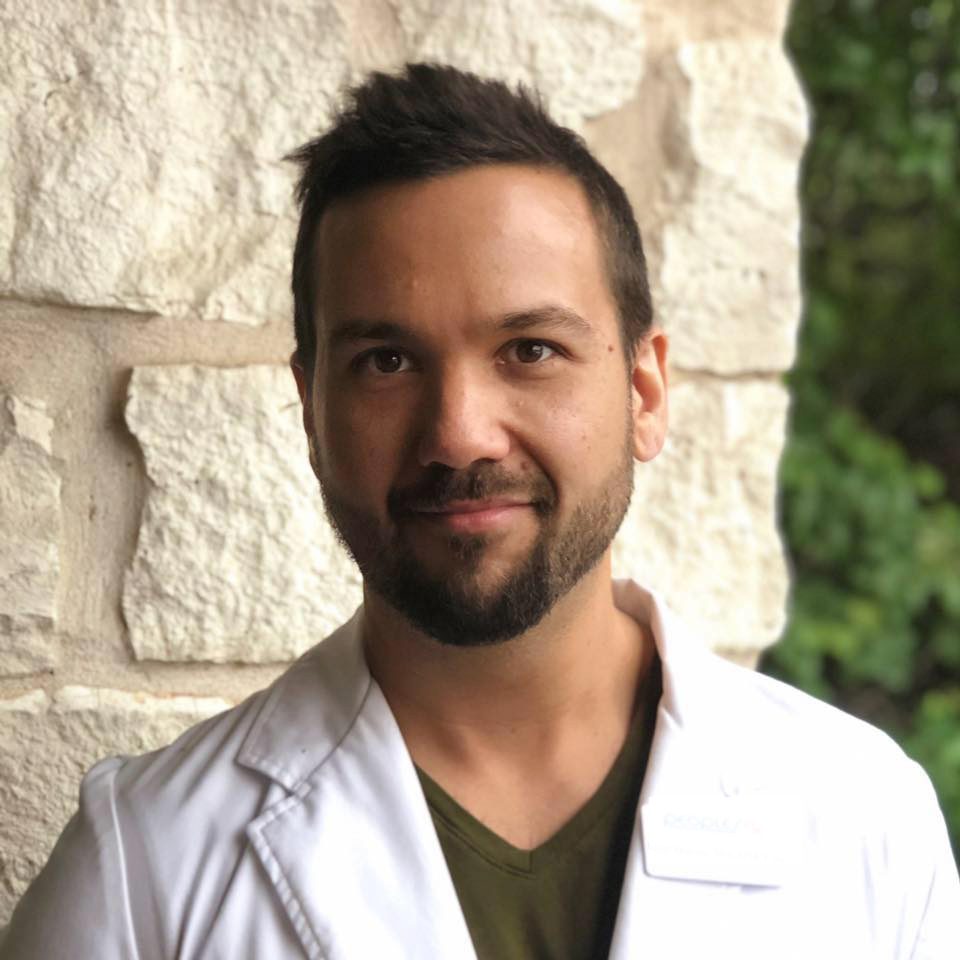What is blue spirulina? In a nutshell, it’s spirulina with a higher ratio of a bright blue pigment called phycocyanin that happens to have a ton of health benefits. Though there are still lots of other great nutrients in it, phycocyanin is where the extra magic comes from.
What is Blue Majik®? It’s a high-grade organic blue spirulina powder that’s carefully dried using a proprietary low-temp process, standardized to contain at least 30% phycocyanins, and subject to extremely stringent purity testing.
It’s also the ingredient we use to impart a brilliant blue color to our ultra-clean pre-workout, Chad Mode, a next-generation product that we proudly formulated without the use of artificial dyes, flavors, sweeteners, or preservatives. We even left out the so-called ‘natural flavors’ >that are really anything but and use organic green coffee fruit for the caffeine. You’d be hard-pressed to find a cleaner pre-workout anywhere else.
We endlessly research every ingredient we use, so consider this article ‘CHOQ-full’ of information, and a tad on the longer side. If you’re in a TL;DR mood or just looking for something specific, feel free to use the table of contents below.
Table of Contents
- Strong pigments = strong health benefits
- What is Spirulina? Not a plant, but something way more interesting.
- Green vs Blue Spirulina: what’s the difference & where does blue spirulina come from?
- Benefits of Spirulina (including both regular & blue spirulina)
- Blue Spirulina and Phycocyanin: benefits & research
Strong pigments = strong health benefits
When you look at the beautiful array of hues found in fruits and vegetables, it becomes obvious that mother nature often wraps some of her most nutritious gifts in the brightest colors. What’s more, though, is that in many cases the pigments themselves are what make the plant so beneficial.
For example, chlorophyll does way more than make plants green and help them with photosynthesis. The same is true for phycocyanin, as it also helps spirulina harvest light from the sun but serves a variety of other important functions.
Both regular spirulina and blue spirulina have been the subject of a number of studies showing a wide array of benefits, such as healthy inflammation response, joint function, antioxidation, immune function, and protection from a variety of toxins like heavy metals and other harmful chemicals that we face in the modern world.
What is Spirulina? Not a plant, but something way more interesting.
Although spirulina is called ‘blue-green algae’, it’s not actually an algae, or even part of the plant kingdom. It’s a bacteria, specifically a kind called ‘cyanobacteria’ called Arthrospira platensis. So what are cyanobacteria, and why do people still call spirulina ‘algae’?
Because spirulina hangs out in the water and has roughly the same color as algae, it was natural to make this assumption a long time ago. Once we had powerful enough microscopes to see that spirulina is a single-celled organism, we decided it was a cyanobacteria, meaning that it’s a special kind of bacteria that uses photosynthesis.
With spirulina, you get the best of both worlds. Just like a plant-based superfood, you get tons of nutrition plus the benefits of chlorophyll, but it’s also incredibly easy to grow since it’s such a simple organism.
Not only does NASA currently feed it to their astronauts, they’re also planning on having them grow it on missions to Mars. According to a scientific paper on the viability of spirulina for space travel, it’s ideal for these missions due to its variety of health and immune-boosting properties, including the ability for astronauts to cope with the many stressors of space travel:
“Spirulina could represent a new technology for the sustainment of long-duration manned missions to planets beyond the Lower Earth Orbit (e.g., Mars); furthermore, it could help astronauts stay healthy while exposed to a variety of stress factors that can have negative consequences even after years…
The recent findings of the capacity of Spirulina to improve stem cell mobility and to increase immune response have opened new intriguing scenarios…”
If there’s anyone who doesn’t mess around with fads, it’s NASA. The fact that they’re taking spirulina this seriously as a superfood speaks volumes about what a big deal it actually is.
Green vs Blue Spirulina: what’s the difference & where does blue spirulina come from?
Blue spirulina isn’t a different species or cultivar of spirulina. It’s the exact same organism (Arthrospira platensis), but with one major difference: there’s a much higher percentage of phycocyanin as a result of concentration or extraction.
Consider the first four letters in ‘cyanobacteria’ and you might spontaneously conjure up the last time you changed a color printer cartridge. Unless you’re an interior decorator or artist, you probably get much use out of the word ‘cyan’.
If you’re hazy on the exact definition, cyan is technically the color exactly between blue and green on the visible light spectrum. The chlorophyll is the green and the phycocyanin is the blue: hence the term ‘blue-green algae’ (even though it’s confusingly not algae at all, as previously discussed).
We’ll get into the specific research behind phycocyanin and the many health benefits of blue spirulina in a moment (click here to go there now), but first let’s lay the groundwork with a short discussion of the properties of spirulina in general, not just the blue kind.
Benefits of Spirulina (including both regular & blue spirulina)
Spirulina is a complete protein that includes all essential amino acids (1). Of course, you’d have to eat quite a lot of it to get a significant amount, but even a couple extra grams of an easy-to-digest, complete protein is nice to have.
It’s also a high-quality source of a wide variety of vitamins and minerals. In particular, it’s an excellent source of carotenoids, the most famous of which is beta carotene, the plant-based version of Vitamin A.
Like chlorophyll and phycocyanin, carotenoids are also bright pigments. Ever heard a story of someone who drank enough carrot juice to turn them slightly orange? Yep, that’s actually real, and it happens because of the high concentration of beta-carotene in carrots.
Carotenoids are excellent to support the health of the eyes and protect it from UV radiation, which is why ophthalmologists love spirulina. One particular carotenoid that it’s rich in is called ‘zeaxanthin’, which you’ll often find combined with lutein in vision support supplements.
A number of animal studies have confirmed spirulina’s ability to protect the eyes from insults such as excessively intense light (2), exposure to formaldehyde (3), and even chemical burning of the cornea (4).
Spirulina is also an excellent source of a hard-to-find omega fatty acid called GLA (Gamma-Linolenic Acid) that works with omega 3s to support healthy inflammation response.
Here’s a quick (but definitely not exhaustive) summary of the many health benefits of spirulina:
- Potent antioxidant (fights cellular damage from free radicals)
- Promotes liver health & detoxification
- Supports removal of heavy metals & radiation
- Healthy inflammation response
- May improve digestion & support the microbiome
- Supports cardiovascular health
- Promotes healthy immune & histamine function
Spirulina, chlorophyll, and healthy blood cell formation
Because of its high chlorophyll content, spirulina also promotes healthy blood cell formation (more on this in the next section).
Fascinatingly, chlorophyll is virtually identical to hemoglobin, the iron-containing protein that carries oxygen into cells in animals. The main difference between the two is that there’s a substitution of magnesium for iron in one part of the molecule. Other than that, they’re essentially the same thing.
In one study, rats that were given chlorophyll saw increases in both red and white blood cell counts (5). Some scientists believe that the body can directly convert chlorophyll to hemoglobin, but that has yet to be fully proven.
Benefits of spirulina for exercise and fitness
One review of multiple studies stated that spirulina can support oxygen uptake and exercise tolerance. The authors concluded that it may be helpful for athletes who do not consume the optimal amount of antioxidants in their diets (6).
A clinical study that used an arm cycling exercise showed improved oxygen uptake during a test that pushed participants toward fatigue (7). That same group of researchers did a follow-up study on professional cyclists and found that spirulina was able to lower heart rate, boost hemoglobin, increase power output, and reduce lactic acid (8).
Another study used an exercise called the ‘Bruce Incremental Treadmill Exercise’, a technique that involves repeatedly increasing the speed and then measuring the cardiovascular system’s responses. The authors found that spirulina had positive effects on lactic acid levels as well as the antioxidants glutathione and SOD (9).
As we said before, we didn’t put Blue Majik in Chad Mode just for the awesome blue color.
Blue Spirulina and Phycocyanin: benefits & research
As mentioned previously, blue spirulina gets its color from its high concentration of phycocyanin, but what exactly is phycocyanin?
Known as an accessory pigment’ to chlorophyll, phycocyanin is also a powerful antioxidant molecule that absorbs light and contributes to photosynthesis. Like chlorophyll, it’s also structurally similar to something that relates to the blood: bilirubin (which comes from broken down red blood cells).
All organisms require antioxidants to function, but organisms that store energy from the sun especially need them to protect themselves from the downside of strong UV radiation: free radical damage.
Just as excessive UV from too much sun exposure can cause oxidative damage to the skin, it can damage plants and bacteria who make their living by bathing in sunlight all day long and converting it to energy. If they didn’t have these antioxidants to counteract this powerful solar radiation, they’d die immediately from all the cellular damage.
As we’ll see in the following sections, many of blue spirulina’s beneficial effects stem from phycocyanin’s potent antioxidant properties.
Blue Spirulina supports healthy inflammation response & joint function
A substantial amount of research has been done on blue spirulina’s ability to promote healthy inflammation response.
In one clinical study, 24 people were given 2.3 grams per day of blue spirulina containing 1 gram of phycocyanin. The researchers found that it was able to support healthy joint function and joint comfort. Blue spirulina also promoted healthy levels of biomarkers associated with liver function (10).
A number of papers have been published discussing the mechanisms of action behind phycocyanin and spirulina’s ability to support inflammation response, citing its promotion of beneficial levels of compounds like COX-2 (11 – 14).
Phycocyanin can protect tissues from a number of toxins and boost natural antioxidant production
When studying whether or not a compound can offer protection against toxicity, researchers will often administer some kind of poisonous substance to rats.
In one study, rats were given a neurotoxic fungicide (and environmental pollutant) called tributyltin chloride, then administered either phycocyanin or NAC, a precursor to the master antioxidant glutathione. The researchers determined that both compounds dramatically reduced oxidative stress from the chemical and helped to protect the rats’ brains from the toxic effects of the chemical (15).
In another study, rats were given mercury at a dose that would cause acute injury to the kidneys. The researchers found that it was able to protect their kidneys from the large dose of mercury, citing its antioxidant properties (16).
Phycocyanin has also been shown to protect mice livers after they were given alcohol. It also boosted levels of a critical antioxidant called SOD (Superoxide Dismutase) (17). SOD is present in all living cells and helps to protect mitochondria from being damaged by free radicals.
The most significant of these kinds of studies for men is one where rats were given mercury and the researchers showed it was able to protect their testes and preserve sperm quality (18). This one was done on regular spirulina, but we still included it here since it’s a similar study design.
Phycocyanin can protect against radiation & support microbiome health
In a study that exposed rats to abdominal x-ray radiation, researchers found that phycocyanin was able to prevent damage as well as support the health of the gut microbiome by increasing the quantity of beneficial bacteria (19).
Another similar study also used X-rays, but applied them to the rats’ chest area instead. The authors concluded that phycocyanin was able to reduce the negative effects of the radiation on the lungs. They also looked at the microbiome of both the lungs and the gut and saw improvements in both (20).
Blue Majik: the ultimate organic blue spirulina and clean source of phycocyanins
When we were formulating our ultra-clean pre-workout Chad Mode, we didn’t want to use synthetic coloring agents like most companies, so we decided to use phycocyanins to give both a beautiful color and additional health benefits. Our next step was to do what we always do: search high and low for the best possible source, which we determined to be E3Live Blue Majik®.
What is Blue Majik and what makes it different from a generic blue spirulina?
Blue Majik is an extremely high grade of organic blue spirulina produced by E3Live that contains at least 30% phycocyanins and undergoes extremely meticulous purity testing.
What do we mean when we say ‘high grade’?
The first answer is that it’s USDA-certified organic, meaning that it’s undergone additional verification to ensure that it’s grown without the kinds of toxic chemicals that you’re taking it to help your body deal with.
The next answer is also pretty straightforward: that Blue Majik doesn’t contain anything but pure organic blue spirulina. There are no fillers or preservatives of any kind in it.
The other two factors that make such a high-end product have to do with how it’s dried and the many labs that are done to prove its safety and purity.
Blue Majik uses a lower temperature drying process
Blue Majik uses a proprietary process called Refractance Window™ drying that exposes the spirulina to lower temperatures in comparison with other techniques such as drum or tunnel drying.
Instead of taking hours to days, this drying process only takes between 2 to 6 minutes, helping to maintain the color and integrity of the spirulina. Less drying time also means that there’s less of a possibility for some kind of unproductive microorganism to grow during the process.
As we’ll see in the next section, it’s essential for spirulina to have proper lab testing, as it has special contamination risks that other supplements don’t. That’s another reason you want to be extra picky when you’re choosing a supplier.
Blue Majik has extensive lab testing
It’s essential for all ingredients to undergo proper testing, but this is especially true for spirulina because it can be contaminated with a number of different toxins and microorganisms if not grown properly.
The FDA requires certain kinds of tests for all dietary supplements, such as heavy metals, fungi, and bacteria. E3Live also tests Blue Majik for a variety of other contaminants that are sometimes found in impure spirulina products, including BMAA, PAH, anatoxin-a, saxotoxin, and microcystin.
Microcystin toxins can damage the liver and have been found in lower-purity brands of algae and spirulina products. They may also be carcinogenic, according to the EPA. A 2023 study found alarming levels in the two products that were reviewed. That’s why this additional testing is so important.
References
1. Ahmad, A. M. R., Intikhab, A., Zafar, S., Farooq, U., Shah, H. B. U., Akram, S., Abid, J., Parveen, Z., & Iqbal, S. (2023). Spirulina, an FDA-Approved Functional Food: Worth the Hype?. Cellular and molecular biology (Noisy-le-Grand, France), 69(1), 137–144.
2. Okamoto, T., Kawashima, H., Osada, H., Toda, E., Homma, K., Nagai, N., Imai, Y., Tsubota, K., & Ozawa, Y. (2019). Dietary Spirulina Supplementation Protects Visual Function…in Mice. Translational vision science & technology, 8(6), 20.
3. Al-Neklawy A. F. (2018). Does oral spirulina protect the cornea from formaldehyde exposure? Application to anatomy laboratories. Clinical anatomy (New York, N.Y.), 31(6), 830–837.
4. Yang, L., Wang, Y., Zhou, Q., Chen, P., Wang, Y., Wang, Y., Liu, T., & Xie, L. (2009). Inhibitory effects of polysaccharide extract from Spirulina platensis on corneal neovascularization. Molecular vision, 15, 1951–1961.
5. Tagauov, Y. D., Abu-Elsaoud, A. M., Abdrassulova, Z. T., Tuleukhanov, S. T., Salybekova, N. N., Tulindinova, G., & Al-Abkal, F. (2023). Improvement of Blood Parameters of Male Rats Exposed to Different Injection Doses of Liquid Chlorophyll. Cureus, 15(3), e36044.
6. Calella, P., Cerullo, G., Di Dio, M., Liguori, F., Di Onofrio, V., Gallè, F., & Liguori, G. (2022). Antioxidant…and immunomodulatory effects of spirulina in exercise and sport: A systematic review. Frontiers in nutrition, 9, 1048258.
7. Gurney, T., & Spendiff, O. (2020). Spirulina supplementation improves oxygen uptake in arm cycling exercise. European journal of applied physiology, 120(12), 2657–2664.
8. Gurney, T., Brouner, J., & Spendiff, O. (2021). Twenty-one days of spirulina supplementation lowers heart rate during submaximal cycling and augments power output during repeated sprints in trained cyclists. Applied physiology, nutrition, and metabolism = Physiologie appliquee, nutrition et metabolisme, 1–9. Advance online publication.
9. Lu, H. K., Hsieh, C. C., Hsu, J. J., Yang, Y. K., & Chou, H. N. (2006). Preventive effects of Spirulina platensis on skeletal muscle damage under exercise-induced oxidative stress. European journal of applied physiology, 98(2), 220–226.
10. Jensen, G. S., Drapeau, C., Lenninger, M., & Benson, K. F. (2016). Journal of medicinal food, 19(7), 645–653.
11. Romay, C., Armesto, J., Remirez, D., González, R., Ledon, N., & García, I. (1998). official journal of the European Histamine Research Society … [et al.], 47(1), 36–41.
12. Reddy, M. C., Subhashini, J., Mahipal, S. V., Bhat, V. B., Srinivas Reddy, P., Kiranmai, G., Madyastha, K. M., & Reddanna, P. (2003). Biochemical and biophysical research communications, 304(2), 385–392.
13. Romay, C., Ledón, N., & González, R. (1998). Inflammation research: official journal of the European Histamine Research Society … [et al.], 47(8), 334–338.
14. Runze Liu, Song Qin, Wenjun Li, Biomedicine & Pharmacotherapy, Volume 153, 2022, 113362
15. Mitra, S., Siddiqui, W. A., & Khandelwal, S. (2015). Chemico-biological interactions, 238, 138–150.
16. Garcia-Pliego, E., , Franco-Colin, M., , Rojas-Franco, P., , Blas-Valdivia, V., , Serrano-Contreras, J. I., , Pentón-Rol, G., , & Cano-Europa, E., (2021). Phycocyanobilin is the molecule responsible for the nephroprotective action of phycocyanin in acute kidney injury caused by mercury. Food & function, 12(7), 2985–2994.
17. Xia, D., Liu, B., Xin, W. et al. Protective effects of C-phycocyanin on alcohol-induced subacute liver injury in mice. J Appl Phycol 28, 765–772 (2016).
18. El-Desoky, G. E., Bashandy, S. A., Alhazza, I. M., Al-Othman, Z. A., Aboul-Soud, M. A., & Yusuf, K. (2013). Improvement of mercuric chloride-induced testis injuries and sperm quality deteriorations by Spirulina platensis in rats. PloS one, 8(3), e59177.
19. Lu, L., Li, W., Sun, C., Kang, S., Li, J., Luo, X., Su, Q., Liu, B., & Qin, S. (2020). Phycocyanin Ameliorates Radiation-Induced Acute Intestinal Toxicity by Regulating the Effect of the Gut Microbiota on the TLR4/Myd88/NF-?B Pathway. JPEN. Journal of parenteral and enteral nutrition, 44(7), 1308–1317.
20. Li, W., Lu, L., Liu, B., & Qin, S. (2020). Effects of phycocyanin on pulmonary and gut microbiota in a radiation-induced pulmonary fibrosis model. Biomedicine & pharmacotherapy = Biomedecine & pharmacotherapie, 132, 110826.






